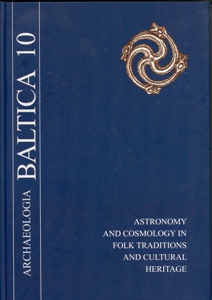Volume 10 (2008): Astronomy and Cosmology in Folk Traditions and Cultural Heritage, December 2008

Order by:
Pub. online: 20 Dec 2008
Type: Article
 Open Access
Open Access
Journal:
Archaeologia Baltica
Volume 10 (2008): Astronomy and Cosmology in Folk Traditions and Cultural Heritage, pp. 52–56
Abstract
Pub. online: 20 Dec 2008
Type: Article
 Open Access
Open Access
Journal:
Archaeologia Baltica
Volume 10 (2008): Astronomy and Cosmology in Folk Traditions and Cultural Heritage, pp. 57–61
Abstract
Pub. online: 20 Dec 2008
Type: Article
 Open Access
Open Access
Journal:
Archaeologia Baltica
Volume 10 (2008): Astronomy and Cosmology in Folk Traditions and Cultural Heritage, pp. 62–65
Abstract
Pub. online: 20 Dec 2008
Type: Article
 Open Access
Open Access
Journal:
Archaeologia Baltica
Volume 10 (2008): Astronomy and Cosmology in Folk Traditions and Cultural Heritage, pp. 66–70
Abstract
Pub. online: 20 Dec 2008
Type: Article
 Open Access
Open Access
Journal:
Archaeologia Baltica
Volume 10 (2008): Astronomy and Cosmology in Folk Traditions and Cultural Heritage, pp. 71–77
Abstract
Pub. online: 20 Dec 2008
Type: Article
 Open Access
Open Access
Journal:
Archaeologia Baltica
Volume 10 (2008): Astronomy and Cosmology in Folk Traditions and Cultural Heritage, pp. 78–85
Abstract
Pub. online: 20 Dec 2008
Type: Article
 Open Access
Open Access
Journal:
Archaeologia Baltica
Volume 10 (2008): Astronomy and Cosmology in Folk Traditions and Cultural Heritage, pp. 86–93
Abstract
Pub. online: 20 Dec 2008
Type: Article
 Open Access
Open Access
Journal:
Archaeologia Baltica
Volume 10 (2008): Astronomy and Cosmology in Folk Traditions and Cultural Heritage, pp. 94–98
Abstract
Pub. online: 20 Dec 2008
Type: Article
 Open Access
Open Access
Journal:
Archaeologia Baltica
Volume 10 (2008): Astronomy and Cosmology in Folk Traditions and Cultural Heritage, pp. 99–104
Abstract
Pub. online: 20 Dec 2008
Type: Article
 Open Access
Open Access
Journal:
Archaeologia Baltica
Volume 10 (2008): Astronomy and Cosmology in Folk Traditions and Cultural Heritage, pp. 105–109
Abstract